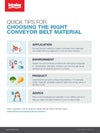Choosing the Right Conveyor Belt Material
3 things to consider before making your decision
- Insights
- November 5, 2021
Belt materials may look similar in their raw form, but they can have completely different compositions. Shown above, plastic pellets prior to belt manufacturing.
This one is high among those critical choices that can make or break your plant’s productivity.
Seriously. No food manufacturer can effectively optimize a plant’s conveyors without taking a hard look at which belt material should be used in a given area.
And be honest. Don’t you just want your belts to run properly and not have to worry about them?
The consequences of making a poor selection can include belt breakages, unscheduled downtime, lower yield, higher costs, material degradation, and foreign material contamination.
To avoid some or all the above, food processors and equipment manufacturers must choose belt materials wisely. How? To find out, we asked the experts who develop, test, and recommend belt materials for our food business customers.
What are the key factors in choosing the right conveyor belt material?
Application
Does the belt need to withstand heavy impacts? What about temperatures, which can range from frying to freezing? Will the belt be submerged in a dip tank?
Examine your specific application and determine what the belt will be put through at that point in the processing line. Doing so can help answer a lot of critical questions about which material is best.

The right belt material can stand up to the abrasiveness of salts and seasonings. Shown above, ThermoDrive incline belting in A23 material.
“Potato processing plants, for example, are a unique environment where it’s crucial to focus on the specifics of the application,” says Drew Downer, Intralox ThermoDrive Mechanical Engineer.
Raw product could come into the plant with sand or dirt on it from outside. Coming from the peeler, potatoes give off starch that’s put into the application. The product may go through a bath of boiling oil, and eventually get covered with seasonings and spices. Each application brings different temperature, physical, and chemical considerations.
“The belt material you choose must be tailored to withstand the impacts associated with each application,” says Downer. Ask yourself, what’s unique about this specific application that’s different from other areas of the plant?
Intralox Team Tip: If your belting must be stored prior to use, avoid exposing it to sunlight. Many materials can’t withstand UV light for long periods of time before they begin to degrade.
Environment
Sometimes, the answer is obvious. (Don’t put belts that are known to be flammable near hot stuff!) Besides ovens, there are numerous environmental factors inside a food plant to consider.
“The actual environment the belt will be in is going to determine what materials are even possible to be used,” says Stephen O’Connor, Intralox Material Specialist. “I start with asking, what is this belt going to see temperature-wise? What about chemistry? What are the other needs and specifications such as mechanical strength? Could there be expansion of the belt material due to moisture?”
Ultimately, the goal is long-lasting, reliable, food-safe uptime. That’s what we try to accomplish with our belt materials, and the selection, development, and deployment of them in the field.
Drew Downer
Intralox Mechanical Engineer
Think about how cleaning solutions can affect your belting, too. Imagine a meat, poultry, or seafood processing plant that must sanitize its belts nightly. Its sanitation crew has used the same sanitizer for a while, which hasn’t been a problem for the plastics in their belts. Suddenly, they’re given a different sanitizer to use. The new product calls for lower concentration, but the team is unaware and continues to use it at the higher concentration level.
“Even small adjustments in the actual chemistry of your cleaner could completely change how your belt performs after a cleaning,” says O’Connor.
For guidance, lean on the expertise of your belting partner. They have the knowledge and insight to recommend what material will work seamlessly and run reliably in your environment.
Product
Is there something unique about the product being conveyed? For example, let’s say your facility processes foods that can be sticky. Some polymers are better suited to release product at a transfer. In this case, choosing the right belt material can help increase yield and reduce carryover.
Similarly, abrasive ingredients such as sugar or cornmeal can wear and degrade belts that aren’t made to hold up against rough or grainy foods. But there are materials created specifically to withstand these types of challenging products.
Your product is always top of mind for you, so keep it top of mind when selecting your conveyor belt material. Since the belt has direct contact with food, its physical and chemical properties should weigh into your decision on which material to use.
Your plant has everything to gain by using correctly specified conveyor belt material.
Before your next belting purchase, think of its application, the area’s environmental conditions, the specifics of the product being conveyed, and even how the belts will be stored prior to operation. It’ll be time well spent. Why?
Better performance, longer belt life, higher product yield, less maintenance, lower costs, and reduced chances of breakdowns are some of the benefits you can expect from choosing the right conveyor belt material.
Of all the potential issues that can arise in a food processing facility, your choice of belt material doesn’t have to be the cause of one. Consult your belting partner and equipment manufacturer early in the process. They can work together and with you to make the right selection.
Then, in the words of legendary inventor Ron Popeil, you’ll be able to “Set it and forget it.”
Connect with an Intralox belting specialist to discuss which belt material is right for your application, environment, and product.


